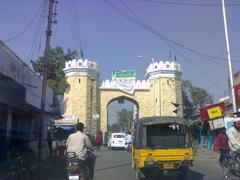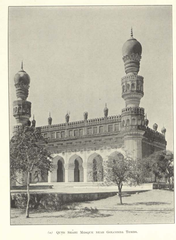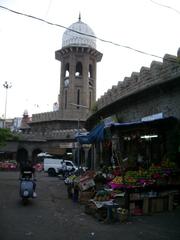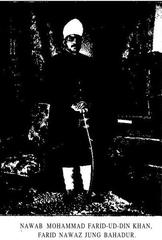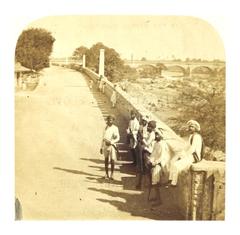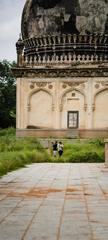
Shaikpet Sarai Visiting Hours, Tickets, and Hyderabad Historical Sites Guide
Date: 04/07/2025
Introduction
Shaikpet Sarai, nestled in the historic Shaikpet neighborhood of Hyderabad, India, is a 17th-century caravanserai that stands as a living testament to the architectural ingenuity and cosmopolitan spirit of the Qutb Shahi dynasty. Built during Abdullah Qutb Shah’s reign (circa 1633–1634 CE), this complex served as a vital resting place on the bustling trade routes connecting Golconda, Bidar, Mumbai, and Machilipatnam. Its strategic placement on the Old Bombay Highway not only underlines its commercial and cultural significance during the Golconda Sultanate era but also offers a unique window into Hyderabad’s layered history (Wikipedia; Uniquely Telangana).
Today, Shaikpet Sarai’s arched corridors, limestone structures, mosque with Persian inscriptions, and tombs remain a source of fascination for history enthusiasts and travelers. Despite decades of neglect and structural decline, recent restoration initiatives involving the Telangana government, Aga Khan Trust for Culture, and heritage organizations are giving new hope to this architectural gem. This guide provides comprehensive information on Shaikpet Sarai’s history, architectural highlights, visiting hours, ticketing, accessibility, current restoration status, and practical tips for a memorable visit.
Contents
- Introduction & Historical Overview
- Architectural Highlights
- Visitor Information
- Visiting Hours
- Ticketing
- Accessibility
- Getting There
- Guided Tours
- Travel Tips
- Nearby Attractions
- Conservation & Restoration
- Frequently Asked Questions (FAQs)
- Conclusion & Recommendations
- Useful Links & References
Historical Overview & Cultural Significance
Origins and Construction
Commissioned by Abdullah Qutb Shah, the sixth ruler of the Golconda Sultanate, in 1043 AH (1633/1634 CE), Shaikpet Sarai was conceived as a fortified caravanserai. While some attributions go to Ibrahim Qutb Shah, most historical records and architectural analysis affirm Abdullah Qutb Shah’s patronage (Wikipedia; Siasat; Hyderabad Mail).
Strategic Location
Located along the Old Bombay Highway in the Shaikpet neighborhood, the sarai was intentionally positioned to serve as a transit hub for traders and travelers between major centers. Its proximity to Golconda Fort and important trade routes solidified its status as a critical waypoint for commerce and pilgrimage (Uniquely Telangana; HydandSeek).
Architectural Features
The sprawling complex originally covered nearly three acres and could accommodate up to 500 people. Key elements include:
- Sarai (Inn): 29–30 ground-floor rooms, arranged along a long arched corridor.
- Mosque: A rectangular plinth (37 x 24 meters), three arched entrances, colorful enameled tilework, Persian inscriptions, and minarets.
- Tomb: An adjacent mausoleum of unknown Sufi origin, built in granite.
- Ancillary Buildings: Stables for horses and camels, and smaller mosque and tomb structures (Wikipedia; Siasat; The Islamic Heritage).
Historical Role
Functioning as a caravanserai, Shaikpet Sarai provided security, shelter, and amenities for travelers and their animals, supporting trade and cultural exchange. The attached mosque and tomb also fulfilled spiritual needs, mirroring the social and religious pluralism of Hyderabad.
After the Qutb Shahi era, the site fell out of use, suffered from flood damage in 1908, and was later repurposed informally before heritage authorities intervened (Siasat; Hyderabad Mail).
Heritage Value
As one of the few surviving caravanserais of the Qutb Shahi period, Shaikpet Sarai is a state-protected monument. Restoration funding exceeding ₹12 crore has been allocated to revive its presence in Hyderabad’s Golconda heritage circuit (Hyderabad Mail; Telangana Today).
Architectural Highlights
- Corridor & Rooms: A rhythmic series of arches and rooms, offering shelter and privacy.
- First Floor: Now partially ruined, but once featured semi-open communal spaces.
- Mosque Features: Three arched bays, Persian inscriptions, ornamental tilework, medallions, carved stone chajja, and flanking minarets.
- Tomb: Granite masonry, arched bays, granite column corridors, dome, and decorative parapets.
- Stables: Located on the west side, a testament to the sarai’s original role as a caravan stop.
- Decorative Motifs: Floral plasterwork, medallions, and crenellated parapets reflect Qutb Shahi artistic sensibilities (The Islamic Heritage).
Visitor Information
Visiting Hours
- Official Hours: 9:00 AM – 5:30 PM daily (subject to restoration progress and site safety).
- Current Status: Access is partially restricted due to ongoing restoration and fragile structures. Confirm visiting status before your trip.
Ticketing
- Entry Fee: Free for general entry (as per state-protected monument policy).
- Special Tours: Heritage walks and guided tours, when available, may require a nominal fee.
Accessibility
- On-Site: Uneven surfaces, partial ruins, and lack of modern ramps limit accessibility for differently-abled visitors.
- Facilities: No restrooms or cafes on premises; plan accordingly.
Getting There
- Location: Shaikpet, Hyderabad, ~12–15 km from city center.
- Transport: Accessible by taxi, auto-rickshaw, and limited public buses. The nearest metro is Jubilee Hills Check Post or Ameerpet, followed by a short ride by taxi or auto.
Guided Tours & Events
- Heritage Walks: Organized occasionally by the Department of Heritage and local groups.
- Events: Special programs during heritage festivals; check official and local listings.
Travel Tips
- Wear sturdy footwear and carry sun protection.
- Bring your own water and snacks.
- Photography is allowed, but drones may require permission.
- Respect the sanctity of mosque and tomb areas.
Nearby Attractions
- Golconda Fort (9–12 km)
- Qutb Shahi Tombs (10–11 km)
- Taramati Baradari (10 km)
- Charminar (15 km)
Combine these sites for a comprehensive heritage day in Hyderabad.
Conservation & Restoration
Significant structural deterioration, including collapsed sections and moisture damage, has plagued Shaikpet Sarai. Restoration partnerships between the Telangana government and the Aga Khan Trust for Culture are underway, focusing on scientific conservation, emergency stabilization, and future visitor safety (Siasat; The Hans India). Updates on reopening and guided access should be monitored through official sources.
Frequently Asked Questions (FAQs)
Q: What are Shaikpet Sarai’s visiting hours?
A: Officially, 9:00 AM to 5:30 PM. Verify current status before visiting.
Q: Is there an entry fee?
A: Entry is free, though special tours may incur a small fee.
Q: Is Shaikpet Sarai accessible for differently-abled visitors?
A: Accessibility is limited due to uneven surfaces and lack of ramps.
Q: Are guided tours available?
A: Occasionally, through local heritage groups or by prior arrangement.
Q: Is it safe to visit?
A: Exercise caution due to ongoing restoration and fragile structures.
Q: Can I combine this with other heritage sites?
A: Yes, it’s close to Golconda Fort and Qutb Shahi Tombs.
Recommendations & Visitor Experience
- Stay Informed: Check updates from Telangana Department of Archaeology and Heritage and Aga Khan Trust for Culture.
- Engage Guides: When available, guides can greatly enhance your understanding.
- Respect Conservation: Avoid disturbing structures or taking artifacts.
- Plan Logistics: Carry essentials and plan for limited on-site facilities.
- Share Experiences: Use #ShaikpetSarai on social media to support heritage awareness.
Useful Links & References
- Shaikpet Mosque and Sarai, Wikipedia
- Hyderabad 400 Year Old Shaikpet Sarai Set For Restoration, Siasat
- Shaikpet Sarai: Architectural Highlights, The Islamic Heritage
- Shaikpet Sarai Revamp Hyderabad, Hyderabad Mail
- Telangana Govt To Restore Shaikpet Sarai In Hyderabad, Telangana Today
- Shaikpet Sarai Hyderabad: Visiting Hours & History, The Hans India
- Telangana Department of Archaeology and Heritage, Official Site
Conclusion
Shaikpet Sarai remains a remarkable, though fragile, landmark in Hyderabad’s historical landscape. Its story is woven into the city’s role as a crossroads of commerce, culture, and faith. While the site currently faces restrictions due to restoration needs, ongoing conservation efforts promise to reclaim its former glory and make it accessible to future generations. By planning ahead, respecting current limitations, and combining your visit with nearby heritage sites, you can enjoy a profound journey into Hyderabad’s past.
For real-time updates, restoration progress, and curated heritage trails, download the Audiala app and follow official state heritage channels.


